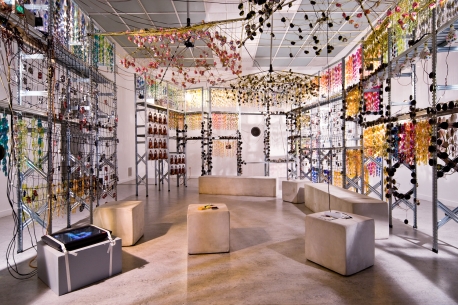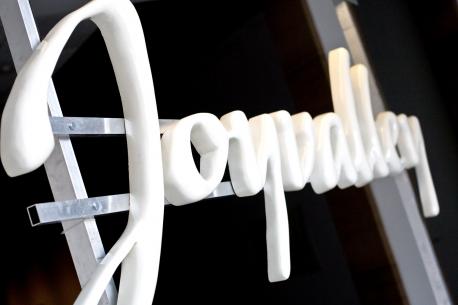
Nr. 18 Place@Space – (re)shaping everyday life
In PLACE@SPACE – (re)shaping everyday life, Z33 takes a look at the relationship between people and their spatial environment, art and technology. People are creative in ‘customising’, personalising and reorganising spaces every day to make spaces personal and intelligible to them. They make their own blogs, decorate their living rooms and follow their own route when walking through the city.
New technologies have made our surroundings more diverse, larger and more complex. In our global society it is easier to cross borders and we can even be ‘virtually’ present in different places simultaneously. Networked and digital environments interact with physical, mental, social cultural and historical spaces. These multi-layered, kaleidoscopic, or hybrid spaces provide a wealth of new impressions. Technology is also becoming more ‘ubiquitous’, by which we mean that technology is everywhere, concealed in the objects that surround us. In other words, technological networks have become less visible in our environment.
In PLACE@SPACE – (re)shaping everyday life, artists, scientists, architects, engineers and designers make the impact of these new technologies visible once more and show how we can use them to reclaim our spatial environment and to make it our own again.
PLACE@SPACE – (re)shaping everyday life shows installations by Paul Casaer (B), GRRRR (Ingo Giezendanner) (CH), Ryoji Ikeda (J), irational.org (UK), Limiteazero (I), Alice Miceli (BR), Haruki Nishijima (J), Egle Rakauskaite (LT), Reconfigurable House Team (HU), Traces of Autism (NL), Arturas Valiauga (LT), Peter Westenberg (B), Jeremy Wood (UK) (more info about the artists here).
The scenography of the exhibition was designed by architect Christian Kieckens.
Z33 invites the visitor to experience and influence the spatial impact of technology. The works by the artists exist in four overlapping areas of tension:
VISIBLE-INVISIBLE
The phenomenon of ‘ubiquitous computing’ is about the fact that technology is being integrated into our surroundings ever more ‘seamlessly’. In many cases we no longer know where technology is concealed, let alone how to manipulate it ourselves. Artists can reveal these invisible networks in interesting ways using maps, visualisations or photos.
LOCAL-GLOBAL
The media has brought the ‘global world’ closer to us. In that sense, artists strategies to reveal the richness of diversity in a global society are very valuable. Via their acts in spaces, they can show us that there are still opportunities to claim our own space in a world that we do not always seem to have a grip on.
NARRATING-CREATING
Immersive environments, interactive story telling or maps tell us a story about our place in space. Artists often use low-tech technologies in their work, as a reaction against the glorification of technological intelligence. As a rule, these works function more transparently or are easy to work with. They bring the possibility of shaping your own space within reach, hereby stimulating a ‘Do-It-Yourself’ (DIY) culture.
PRIVATE-PUBLIC
Technology enables us to be constantly in contact with places from a distance. This gives us enormous freedom. The shadow side is that the same technology allows us to control more. Artists try to draw attention to controlling networks that are not always visible to us, such as databases, RFID (radiofrequency identification) or surveillance cameras. This enables us to interact with them more consciously and maybe even break the connection now and again.



